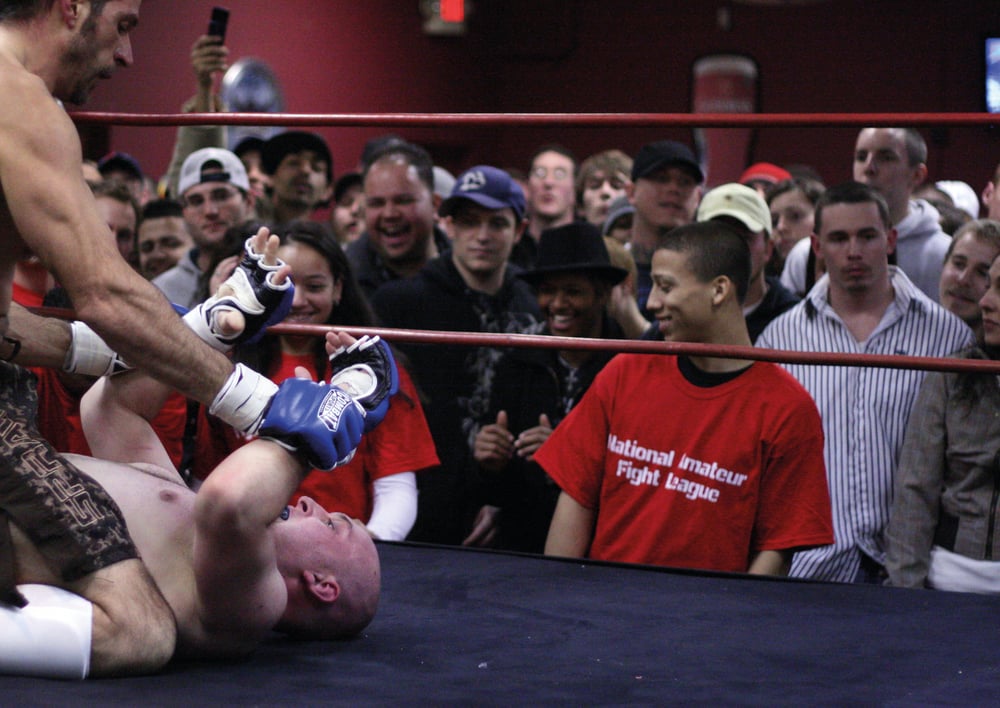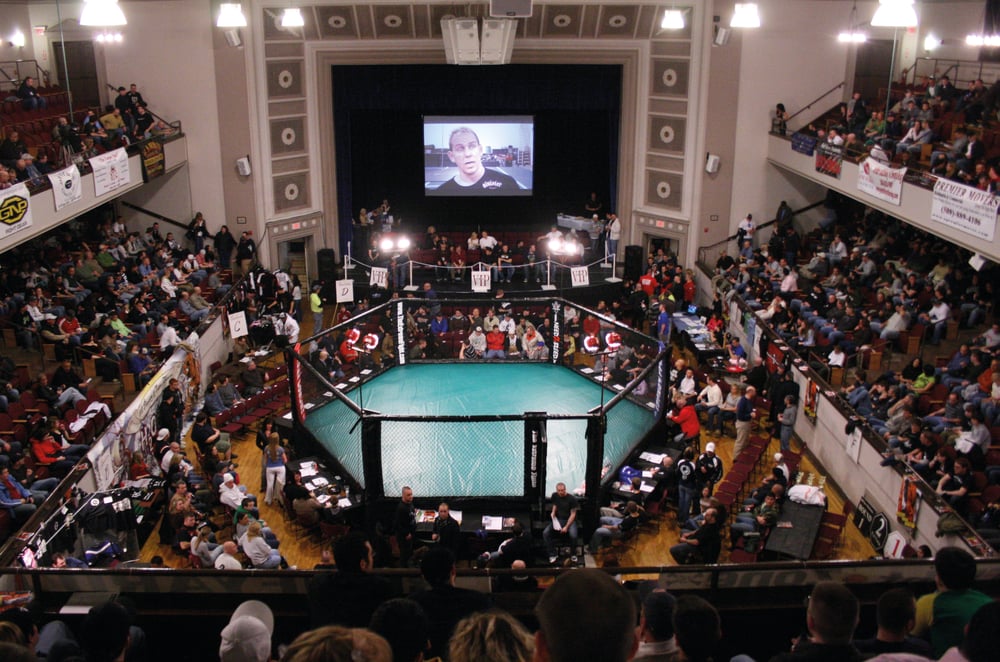
Issue 058
January 2010
It was about three years ago that an 11-2 lightweight from Bridgewater, Ma., made a splash in the UFC. Fighting on UFC 63 against Jens Pulver, the unheralded Joe Lauzon shocked the world when he TKO’d ‘Lil’ Evil’ inside the first round in his debut in the Octagon.
Even though Joe Lauzon had entered the cage that night an incredible underdog, his win over the former lightweight champ wasn’t surprising to fans from his home state who’d watched Lauzon compete throughout New England as a Reality Fighting Lightweight Champion.
Three years on and skilled fighters are popping up everywhere, but the main reason the northeastern region has become such a breeding ground for talent is the opportunity to gain experience. Here, a fighter with dreams of making it big in MMA can compete just about as often as he wants to. The region is filled with working-class guys whose regular jobs suffer from training, not the other way around. Most work a 9-to-5 on weekdays like everyone else, but then hit the mats from seven until nine pm and travel many hours every weekend to seek out fights.
There are a good few hundred active fighters and a dozen or so promoters to fight for, so anyone who wants to make his name has plenty of options. It’s all about building win streaks, fighting often and taking belts – and doing whatever it takes to get noticed.
One of the region’s most famous fighters is the 25-year-old Lauzon, who has his own theory on why the area is such a hotbed for MMA. “I think we have good schools [in the Northeast], but I think part of it too is because we have so many fights or events in Massachusetts,” he says. “On any given weekend you can have two or three promotions going on. I think New England was kind of overlooked for a long time because the future wasn’t so big out here. It was always really big on the West Coast, but after a bit of a slow start I think we’re really coming around.”
It took the UFC over 15 years to amass 100 fight cards, while New England-based organizations such as Full Force Productions, with their ‘Untamed’ events, have managed to put together 30 shows in just four years. While the big shows are undoubtedly more fun to attend than others, every small show provides fans with an opportunity to see the sport (as well as the fighters) up close and personal.
Joe and his brother, Dan Lauzon, rarely miss a local fight card as they lead their soldiers from Team Aggression into battle each month, but that’s just the tip of the iceberg.
Elsewhere in Massachusetts the world-famous trainer Mark Dellagrotte leads the Sityodtong camp, Marcus Davis has Team Irish, and Jorge Rivera is always very vocal when it comes to cornering his fighters.
“I think Boston, right now, is the ‘City of Champions’,” said welterweight John Howard shortly after his Octagon debut at UFC 94. “I mean, certain cities have their time and right now it’s ours. We got the Red Sox who just won [the World Series], the Celtics just won [the NBA Finals], the Patriots were winning not too long ago – as an athlete, when you see others in your area become champions it pushes you – whether your sport is baseball, basketball or MMA, it doesn’t matter.”
There are more fights in Massachusetts than in any other state throughout the Northeast, but while MMA is a way of life for people in towns like Taunton, Bridgewater and Somerville, it isn’t sanctioned. Pennsylvania, New Jersey and New Hampshire operate under the direction of the state’s athletic commission, but in New York and Connecticut MMA events are only allowed on Native American reservations, where they are sanctioned by the local tribe’s own athletic council. In Massachusetts, the judges, doctors and referees are all qualified professionals, but not sanctioned by state officials.
This is why the UFC has yet to come to Boston, even though it’s where Dana White was born and raised, and why Lauzon and Kenny Florian (two of the company’s fan favorites) recently lobbied for MMA to be regulated in their home state.
Jeff Blatnik, a native of New York who won a gold medal in the 1984 Olympics for Greco-Roman wrestling, went to the capital to lobby for MMA in his home state, but, while a bill has been drafted and introduced it has yet to be voted on. It’s insane to think that some of the most famous fights of all time have taken place at Madison Square Garden in New York City, but while the state as a whole currently objects to the sport, MMA fights in New York have been cast into casinos and convention centers on Native American land. State laws have made it impossible to legally compete in New York, but there are still plenty of talented fighters living and training in the Empire state.
One example is The Bombsquad. The team travels 500 miles or more each weekend so their fighters can compete, and they’ve turned out successful fighters at an incredible pace. They transformed Tamdan McCrory from a 6’4” skeleton into a fierce striker called ‘The Barn Cat’. They took Pat McGreal, a cross-country runner with no fight experience, and turned him into an undefeated featherweight with a knockout by spinning back-fist on his resume. Coach and magister Ryan Ciotoli’s biggest success story to date has been producing the undefeated UFC light heavyweight Jon ‘Bones’ Jones.
Ciotoli recruited Jones right out of college and organized the official ‘Jon Jones Summer Tour’ in 2008, when he put the untested 205lb fighter forward for five back-to-back matches before any opponents could say, “Jon who?” Jones became 3-0 in just 13 days as a pro fighter, taking matches on three consecutive weekends. He soon caught the eye of UFC matchmaker Joel Silva.
“Before getting into MMA I was a wrestling coach at Ithaca College for six years and I learned a lot from it,” said Ciotoli. “The head coach there not only taught me a lot about wrestling, he prepared me to be a coach and a good recruiter. I think that’s what a lot of teams are lacking – a coach or somebody involved in the program to go out and recruit good athletes. I was one of his top recruiters and would always get a guy who fit our program. It’s not about having a lot of money, just knowledge on how to run a team and recruit and be successful.”
The team’s headquarters is based in Cortland, N.Y., and they literally have an army of guys. At any time in their gym, almost a dozen fighters can be found preparing for a fight of some kind. This past January they had five fighters compete at Raging Wolf in Salamanca, N.Y., and nine fighters ready to go the very next weekend for World Cagefighting Alliance in Atlantic City, N.J., Combat Zone in Salem, N.H., and UFC 94 (Jones vs Bonnar) in Las Vegas. “It’s tough and it takes a lot of commitment from myself, our coaches and the athletes,” says Ciotoli.
“It’s not easy taking a six-hour drive somewhere and trying to get good sleep. Not to mention a lot of our guys will be cutting weight during the drive too. A lot of teams and fighters aren’t willing to travel like we do, but at the same time a lot of our guys are used to it, because it’s all they know.”
The lifestyle is not for everybody; driving hundreds of miles just to find a fight, sleeping six to a hotel room with sometimes just one bed, and warming up for fights in hallways before fighting in bars or hotel ballrooms.
On the local level, a 0-0 fighter is lucky to earn $300 to fight and $300 to win, while headliners on these events might take home $1,000 and $1,000. It’s a far cry from other professional sports such as baseball and football, where the New York Yankees just spent $250 million dollars on contracts for three players. What’s ironic is how many of those ballplayers idolize the mixed martial artist.
More and more professional athletes are being sighted in and around the cage, either as spectators or combatants. Just weeks after winning the Super Bowl, wide receiver Plaxico Burress sat ringside for EliteXC’s event in Newark, N.J. More recently at WCF 8 in Wilmington, Ma., Celtics’ forward Glenn ‘Big Baby’ Davis took in all 12 bouts just six seats down from Kimbo in the front row of the Shriners’ auditorium.
“East Coast people are a little rough around the edges and really take to the sport,” says Marc Dellagrotte, trainer of UFC stars such as Ken Florian, Patrick Cote and Marcus Davis. “They’ve got an aggressive attitude. We joke, laugh, rag on each other – it’s a different kind of place to grow up. It’s cold all the time and you see people out here shoveling snow with no gloves on. We’re all hard workers. I think both the fighters and the fans show that grittiness.”

Vermont’s Green Mountain Boys are among the grittiest. These two fighters, Nate Kittredge and Glenn Brown, have no gym, no coaches, and no regular training partners save each other, but have still managed to succeed in their sport. They’re virtually the only successful fighters to emerge from Vermont in recent years; both ex-wrestlers from small towns with dirt roads and next-to-no cell phone reception. The ‘GMB’ prepare for every match by getting in the car and leaving the state for mat time with other schools.
“We’ll either drive 300 miles to Cortland to spar with the Bombsquad or head over to New Hampshire, like three hours away, to roll with Team Burgess,” says Kittredge, the current Untamed and Reality Fighting middleweight champion. “It’s not easy, but we do what we have to do to prepare for every match.”
Neither Kittredge nor Brown are known for their jiu-jitsu or submission ability. They can’t even name the current UFC champs in their own division, but their takedowns are awesome and the two will stand and trade punches with anybody. They epitomize what the Northeast is all about; working-class guys who feel they’re tough enough to take on the best around. So that’s just what they do.
It’s like John Howard says, when you see other athletes succeed in your area, it pushes you. Northeastern fighters remember when Lauzon crushed Pulver in his UFC debut. They remember seeing Jon Jones go from 0-0 to a UFC pro just three months after his career had started at Untamed 20. So is it any wonder fighters from the region are thinking, “Why not me? We’re from the same town, we’ve fought in the same places.”
There are plenty of great trainers and schools in the Northeast, and more than enough organizations to leave your mark in. That is why fighters from the area believe they can become the next Georges St Pierre if they work hard enough. Rashad Evans is a New York native; who’s to say another champ won’t come from the region one day soon?
Well-known fighters from the North East
New York
- Rashad Evans, UFC, 205
- Matt Hamill, UFC, 205
- Matt Riddle, UFC, 170
Maine
- Dale Hart, UFC, 155
- Marcus Davis, UFC, 155
- Tim Boetsch, UFC, 205
New Jersey
- Frank Edgar, UFC, 155
- Kurt Pellegrino, UFC, 155
- Deividas Taurosevicius, WEC, 145
Massachusetts
- Josh Grispi, WEC, 145
- Kenny Florian, UFC,.155
- Jorge Rivera, UFC, 185
Pennsylvania
- Eddie Alvarez, Dream, 155
- Paul Bradley, Strikeforce, 185












